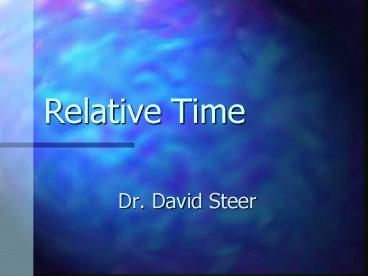Relative Time - PowerPoint PPT Presentation
Title:
Relative Time
Description:
Relative Time Dr. David Steer Introduction Relative Time - How do scientists determine the sequence of geological events? Absolute Time - How do geologists figure out ... – PowerPoint PPT presentation
Number of Views:80
Avg rating:3.0/5.0
Title: Relative Time
1
Relative Time
- Dr. David Steer
2
Introduction
- Relative Time - How do scientists determine the
sequence of geological events? - Absolute Time - How do geologists figure out the
ages of rocks, and hence the age of Earth?
3
How do you normally remember the order of events?
4
Place these events in some logical order
A) MTV Founded
B) Persian Gulf War
C) JFK Assassinated
F) Challenger Explodes
E) Man lands On Moon
D) World Trade Center Destroyed
5
Oldest to Youngest
1
2
3
E) Man lands On Moon
A) MTV Founded
C) JFK Assassinated
4
5
6
F) Challenger Explodes
B) Persian Gulf War
D) World Trade Center Destroyed
6
Three principles used to determine relative order
of geological events
- Principle of Superposition
- Principle of Cross-cutting Relationships
- Principle of Original Horizontality
7
Superposition
- Layers (beds) at the bottom of a sequence of
sedimentary rocks are oldest - Rocks at the top are youngest
Youngest
Oldest
8
Which layer is oldest?
- Layer 1
- Layer 2
- Layer 3
- All same
Layer 1
Layer 2
Layer 3
From http//www.geo.cornell.edu/geology/classes/g
eol326/photos.html
9
Cross-cutting Relationships
- Older rocks may be cut by younger geological
features - Might be an igneous intrusion
- Might be filling of an eroded feature
10
If I use a pen to poke a hole in the stack
What is the youngest event?
What does the pen do to the other units?
11
Cross-cutting Relationships
Igneous rock cuts earlier layering
Layered rock formed first
12
Which rock is the youngest?
A
- A
- B
- C
- D
B
C
D
13
Which statement is false?
- D crosscuts B
- D crosscuts C
- C crosscuts D
- B was deposited
- before A
A
B
C
D
14
Now tilt and bend the stack
15
Original horizontality
- Sedimentary rocks are deposited in horizontal
layers - Tilted or folded layers indicate deformation
following deposition
16
How do we match sequences across large areas?
- Correlation used to determine relative ages of
rocks across continents - Correlation matches fossils and physical
characteristics in sedimentary rocks
17
Index Fossils
Best correlations use index fossils that
represent a short time period but are found
across a large region
18
Which statement is true?
- Layer 1 is older than layer 3
- Layer 2 is the same age as layer 3
- Layer 3 is younger than layer 2
- Layer 2 is older than layer 1
Layer 1
Layer 2
Layer 3
From http//www.geo.cornell.edu/geology/classes/g
eol326/photos.html
19
Place these units in order from oldest to youngest
20
Draw this cross section
Unit B Basalt crosscuts all older units and
covers a shale unit. Event F Stream cuts
partially into limestone unit. Unit L Chemical
sedimentary rock that was deposited directly on
top of low silica extrusive unit. Unit M Oldest
unit is plutonic rock that was partly
eroded. Units S Sandstone that formed over the
non-shell bearing limestone rock unit. Unit R
Light colored extrusive rock that completely
crosscuts and covers all other units. Unit C
Small grained clastic rock deposited directly
over granite.
21
Student Examples































